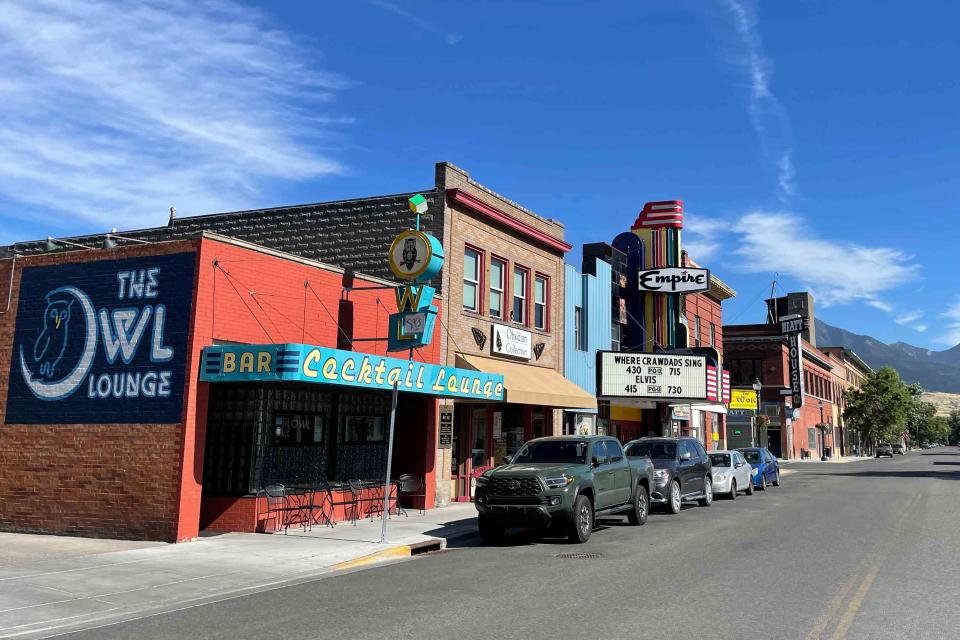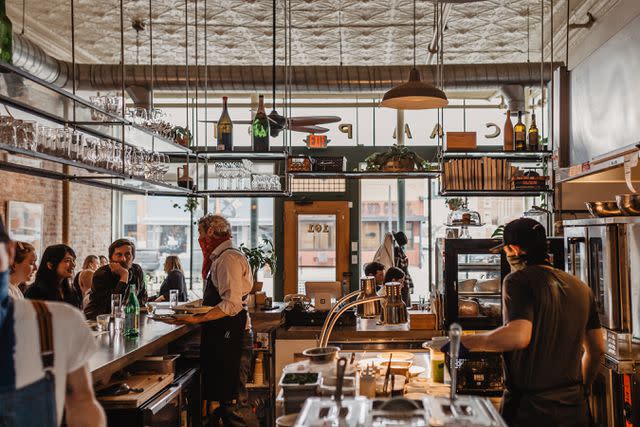An Incredible Food City Is Hiding in the Rural West
In a picturesque Montana town, one writer finds food that's worth the detour while en route to national parks.

Maggie Hennessy
My husband and I had been on the road for almost a week, on an epic road trip last August from Las Cruces in southern New Mexico to West Glacier, Montana, just shy of the Canadian border. We’d already plotted our return route via Yellowstone National Park and Colorado’s Million Dollar Highway before wending home along New Mexico’s old Route 66.
Save for a few posh mountain-town exceptions, our meals consisted largely of oft-greasy handhelds wolfed down over lap napkins in our green pickup truck. Then my friend Margaret messaged me: “Are you anywhere close to Livingston, Montana? You have to try this Italian restaurant Campione!”
When you’ve clocked almost 22 hours of driving with half the total mileage still to go, adding time for a meal seems frivolous bordering on absurd. But as I assembled the next day’s ham and cheese sandwiches on three-day-old bread, my inner bon vivant cried out for handmade pasta and a carafe of good wine. So I booked us a 5 p.m. dinner reservation, put on my sole pair of good pants, and we tacked two hours onto our route to West Yellowstone for a stopover in this southwestern Montana city. And, boy, was I glad we did.
“Did we miss the exit?” I asked, as we pulled off 90 East onto 10 West amid rolling farmlands and zero evidence of a town, a trademark of historic rail settlements dotting the American West.
:These Are America's Next Great Food Cities
Suddenly, diminutive Livingston materialized as a neat grid of low-slung brick structures framed by the Absaroka and Crazy mountain ranges. During the few hours we spent wandering this picturesque town strewn with galleries and antique shops, we’d discover a budding dining haven that’s celebrating the edible bounty of Montana beyond bison and beef. We hadn’t even finished our pastas at Campione when I found myself already searching for excuses to plot a return trip to this corner of the Big Sky state, if only to squeeze in a couple more meals, not least of all at this memorable, Roman-inspired restaurant.

Rio Chantel / riochantel.xyz
Colorful mid-century signage bedecked downtown’s Empire Twin Theater and historic Murray Hotel, into which we briefly stopped for a Montana pilsner at the lively, namesake Murray Bar. Woodfired pizzas dashed by our spots at the U-shaped bar. A few stools down, a woman and her father recounted their mixed success fishing, and four thirty-somethings agreed on one more round.
Campione was already filling up too when we walked in just after opening, though its vibe leaned decidedly serene. Natural light flooded the airy room through the floor-to-ceiling windows comprising the facade. The white hexagonal tile floors, painted tin-print ceiling, and exposed brick conspired elegantly to suggest a restaurant that had been open a decade rather than one year (now 18 months).
:The Best Gas Station and Truck Stop Food in America
“The building [built in the 1890s] did a lot of the work for us,” partner Anthony Sferra, who also oversees baking, told me later. “We did a lot of renovating, but it was more of a reclaiming of the space — getting rid of the linoleum floors, taking stuff out of the windows.”
Over glasses of fresh, citrusy Sicilian Catarratto white, we snacked on juicy cantaloupe canoes draped in prosciutto and drizzled with grassy olive oil. Fritto misto spilled from their butcher-paper cone; their crunchy cornmeal crusts encased toothsome squid, tender mussels, and springy shrimp, which we dunked in tangy preserved lemon aioli.
Sferra, along with partners Jeffrey Galli (who oversees front of house and events) and head chef Joshua Adams, originally envisioned Campione as a quick-service mix between a Roman cafe and trattoria — the bustling sort of place where “you scream, ‘Pasta’s ready!’ across the restaurant,” Sferra said. “But because of the societal and public health restrictions surrounding Covid, we had to rethink the concept a bit.”

Maggie Hennessy
They took their collective foot off the gas, expanded the food and wine menus, and spread out tables to facilitate a more full-service experience. But they were anxious, and not just because of the pandemic. These three service industry vets are all Livingston transplants — Sferra grew up in Australia, Galli in New York, and Adams spent his childhood in Taiwan. They weren’t sure how the community would respond to a restaurant that would feel at home in Park Slope, Brooklyn, despite knowing that Livingston was in need of dining diversity.
:The 5 Best Wine Road Trips in the U.S.
“When I first moved here, it was just the Rib & Chop House and Second Street Bistro, which is a classic French-style bistro on the higher end,” said Adams, who’s been in Livingston the longest, since 2009. “Livingston had a more spaghetti Western feel — all steak and potatoes and pizza, but like Pizza Hut, Dominos style. There weren’t many options out there in terms of diversity of food. It was just totally focused on beef.”
A creative enclave
Campione sits at the physical crossroads of the city, which itself originated as the nerve center for thousands of miles of rail — and the first gateway to Yellowstone. A grid-shaped town was erected around the railroad station with theaters, hotels, banks, and restaurants, with expectations of a population boom. As interstate highways slowly overtook rail and workers left, a prolonged economic depression left storefronts vacant by the ‘80s. But then came the writers and artists, drawn to what Galli calls “this really appealing, beautifully built space,” which became “a sort of haven for the liberal-minded in a greater, rural community of farmers.”
Livingston’s population of nearly 8,400 still includes a disproportionate number of artists and writers. Indeed, you’ll feel that spirit in the numerous galleries and studios that occupy downtown storefronts and when you wander the weekly farmers market, where artists rival the produce and meat farmers in number.
Adams thus kicked off Campione’s menu development in the spirit of compromise: building the perfect, luscious meatball — an Italian-American restaurant must — out of Montana-raised beef and pork, doused in housemade red sauce and sharp pecorino. But he’s keen to showcase the state’s lesser-appreciated homegrown bounty through a “Montalian” lens — including farro, barley and lentils (which accompany his cornmeal-crusted lake trout in anise-kissed cioppino broth), seasonal produce and herbs, and local lamb.
:The One Thing You Have to Eat in Every State
The latter mingled with peak-season grape tomatoes and soft leeks in our order of summery lamb ragù, which coated a tangle of linguine sourced from an artisanal maker in town. Sferra’s pillowy focaccia — redolent of cracked pepper — was the perfect vehicle for getting every last bit of sauce off our plates.

Rio Chantel / riochantel.xyz
As Adams has built trust, he nudges diners out of their comfort zones via specials like grilled bison hearts and romesco-stuffed sardines. There’s been a little pushback; the occasional negative review may lament the lack of chicken alfredo, Galli noted with a laugh. Overall, the community has embraced them to the tune of regulars who come as often as three nights a week. (It helps that entree price points don’t exceed $26.)
“It’s comfort food — simple ingredients, simply delivered, but maybe in a way you’ve never had before,” said Galli. His favorite example is Adams’ manicotti — hand-rolled and stuffed with ricotta and sweet caramelized onions, then submerged in oxtail consommé with bits of shredded oxtail, mushrooms, and spinach.
“Classed up, but still really approachable,” Adams added.
Destination eaters from Bozeman and other parts of Montana and wayfarers like me en route to national parks are catching on too, which Team Campione sees as a chance to help this small city thrive. After all, Campione translates to champion — which in this case “is not as much in the sense of the victor, but this idea of this restaurant as a champion for our community and for us, but also for the food scene in Livingston,” Galli said.
:Why You Should Plan an Idaho Wine Trip
My husband and I lingered over our chocolate gelato with Marcona almond-espresso brittle and watched a server light tabletop candles amid the pleasing din of chatter and clinking dinnerware.
Outside, the golden hour was descending, urging us back on the road to reach our final destination before dark. Yet some time during this respite from our endless rambling, we felt reinvigorated — to the rugged, vast beauty of the West that still awaited us, and to the delights that may come from saying yes to deliciously impractical detours.
Where the Team at Campione Eats in Livingston:
The Mint Bar & Grill for classic upmarket bar fare — simple food, done well. Think grilled ribeye steaks, pork chops with apple, and (dare we say) the best burgers in town.
2nd Street Bistro in the Murray Hotel for traditional French bistro dishes that incorporate Montana’s bounty, as in bison striploin steak frites and ravioli with house ricotta, wild mushrooms, and leeks.
Los Pinos for authentic Mexican and modern Tex-Mex, from charbroiled chicken in house mole to chicken fried steak smothered in ranchero sauce.

